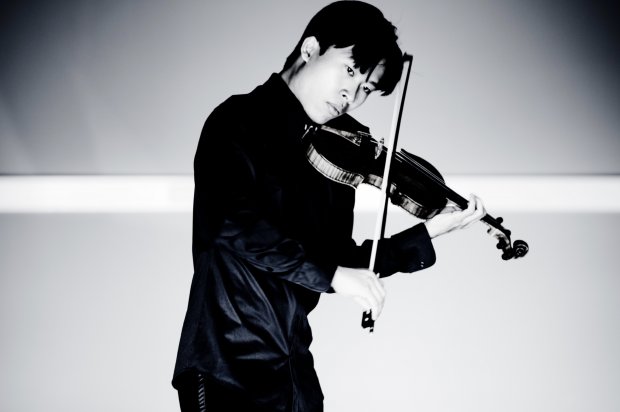The programme for the concert I attended at the Atatürk Cultural Centre in Taksim Square on January 5, 2024 consisted of only two works: Prokofiev’s Violin Concerto No 1 in D major and Bruckner’s Symphony No 4. Both were played by the Istanbul State Symphony Orchestra under the direction of Alfonso Scarano (the Italian chief conductor of the Thailand Philharmonic), while the soloist for the concerto was the young Canadian violinist Kerson Leong (pictured above, courtesy of the artist's website).
When Sergei Prokofiev (1891–1953) wrote his first works, he was influenced by the iconoclastic abrasiveness of Stravinsky’s Rite of Spring (1913), and his Piano Concertos Nos 1 and 2 are regarded as early efforts to conform to this trend: even the slow parts are more tough than tender, and the opening of the third movement of the Concerto No 2 is an exercise in brutal primitivism. With his Violin Concerto No 1 in D major, however, he found a more personal and authentic voice: now that spiky, discordant guard is occasionally lowered, and in the first and last of the three movements a new-found lyricism is allowed to peep through.
It is interesting, perhaps, that the softening of his musical idiom should coincide with such a turbulent period in Russian history: 1917, the year of the concerto’s composition, saw the February and October Revolutions – which Prokofiev (never a man of socialist tendencies) very sensibly sidestepped by retreating to the Caucasus. There, in addition to this work, he composed his Classical Symphony, his uncompromisingly severe Piano Sonatas Nos 3 and 4, his epigrammatic and occasionally Satie-like Visions fugitives for piano and Seven, They Are Seven, a cantata that induces – in me, at least – visions of insect armies marching to war.
(An aside: Prokofiev was born in the early degrees of placid Taurus, but action-addict Mars was squaring off with stonewall Saturn, thus producing a standoff between an unstoppable force and an immovable object that must have been a source of endless frustration for our composer. The tension of this aspect was further intensified by a square to Jupiter – which, in turn, was exactly opposing Saturn. Also, his Sun was opposed by let’s-tear-it-all-down Uranus in the problematic last degree of Libra. Little wonder, then, that the poor man suffered from high blood pressure. This condition unfortunately remained undiagnosed, and in January 1945, only days after the triumphant first performance of his Fifth Symphony, it resulted in a fall during which he banged his head. The severe concussion he suffered on that occasion led to headaches, nausea and dizziness, eventually triggering the cerebral haemorrhage that carried him off on March 5, 1953 – an hour before Joseph Stalin, too, breathed his last. Dense crowds on their way to Red Square to pay their respects to the former dictator thronged the streets of the city centre, thus preventing the hearse from reaching Prokofiev’s apartment opposite the Moscow Art Theatre. Indeed, it was only several days later that the coffin was able to be carried out of the building. As a final insult, his family was obliged to decorate the casket with paper flowers as Moscow’s florists had been ordered to contribute every last bloom in their possession to Stalin’s funeral.)
Prokofiev’s Violin Concerto No 1 had originally been scheduled to receive its first performance in St Petersburg in November 1917, but for entirely understandable reasons the event had to be cancelled. Instead, a version for violin and piano was played by Nathan Milstein and Vladimir Horowitz (both, incidentally, Jews from Ukraine), and this rendition by two highly distinguished musicians was very favourably received. Herbert Glass, writing on the LA Phil website, has this to say about the delayed first performance of the full orchestral version (which took place in Paris in 1923) and the work’s reception:
Prokofiev was by that time living in the French capital, having left Russia shortly after completing the Concerto for what he termed ‘a brief concert tour’ of the West. (The tour was to last for 15 years.)...
The Concerto made an equivocal impression, the progressives finding it too conservative, the conservatives too progressive (it does, indeed, straddle two worlds). Within a matter of months, however, it had become a hit, a consequence of the orchestra-less Russian premiere, and the subsequent performance of the full version by Szigeti and an orchestra conducted by Fritz Reiner at the 1924 Prague Contemporary Music Festival.
The two worlds referred to above are those of 19th-century Romanticism, amply displayed in the luscious first and third movements, and the second movement’s 20th-century world of motoric rhythms, of which Prokofiev and Stravinsky were co-inventors.
I’m not quite sure the first and third movements can be accurately described as ‘luscious’: the mellifluousness is interspersed with sweet-and-sour passages, and occasionally by even sterner stuff. I would agree, however, that the concerto as a whole ‘straddles two worlds’, that the first and third movements (especially the latter) end in a contented, relaxed mood, and that the frequency with which the chords in these two movements are anchored in a recognisable tonality might be adduced as evidence of ‘conservatism’. The second movement is, of course, a quite different kettle of nails: the ‘20th-century world of motoric rhythms’ comment is entirely accurate. Here is a 1954 recording in which David Oistrakh is accompanied by the London Symphony Orchestra under the Croatian conductor Lovro von Matačić.
This work makes heavy demands on the soloist, and Kerson Leong, who is of Eastern appearance (his website doesn’t tell us anything about his origins), rose to the occasion, producing a polished performance. A quote from the aforementioned website:
Forging a unique path since his First Prize win at the International Yehudi Menuhin Violin Competition in 2010, he continues to win over colleagues and audiences alike with “a mixture of spontaneity and mastery, elegance, fantasy, intensity that makes his sound recognizable from the first notes” (Le Monde).
I definitely agree about the elegance and the intensity (his rich and gutsy tone being a special treat), though there were the occasional hitches: he botched the awkward transition from C-plus-B to B-only at the end of the meno mosso solo section of the first movement, and his intonation in the fast-and-furious Scherzo second movement was not always one hundred percent accurate. In the main, however, his playing displayed a rare combination of sensitivity on the one hand, and confidence and panache on the other. In addition, the feeling of tension that is often evident in this work came over well. The fact that he made a hit with the audience is not at all surprising: rarely does one see this level of expertise in such a young performer. Mr Leong gave two encores, both of which were rapturously received.
The second half of the concert was taken up by Bruckner’s Symphony No 4. Though this long work, which usually takes over an hour to play, was titled ‘Romantic Symphony’ by the composer himself, I personally do not see it as any more romantic than his other productions in the genre: for my money, his last three symphonies (Nos 7, 8 and 9) are even more up-front emotionally than this one. Being a former horn-player, I am only too aware of the many exposed horn solos No 4 contains, and when listening to it I always feel nervous when yet another trial by fire is coming up for whoever has the job of playing them. (At the end of this particular performance, the first member of the orchestra the conductor went over to raise to his feet and be applauded was none other than the First Horn – nice to see credit given where credit is due!) Thus, I regard the Fourth Symphony not as a hearts-and-flowers fest, but as a butterflies-in-the-stomach beano. This is only my personal take on it, however: well received at its first performance in Vienna in 1881, it remains one of the composer’s most popular works.
Anton Bruckner (1824–96), a detail-conscious Virgo born with an uncomfortable square between his Sun and demanding, nitpicking Saturn, was highly self-critical, and frequently revised his works – resulting in a plethora of differing versions. I shrink from attempting to unpick the appalling tangle of information (liberally spiced with conjecture and misunderstanding) that surrounds them, however, and thus cannot say which of the multiple versions of the four-movement Symphony No 4 it was that we heard on January 5.
Hugh Macdonald, on the LA Phil website, gives an account of the work that includes an excellent description of Bruckner’s style. In fact, these features can be seen, by and large, not just in this particular symphony but in all nine of them.
Bruckner’s symphonic style is broad and leisurely. Haste and condensation play no part in his structures. He lays out his themes one by one and builds upon them in monumental fashion. Despite his enthusiastic admiration for Wagner, he does not call for Wagnerian immensity in his orchestration, confining himself to the size of orchestra that Beethoven had at his disposal, with no percussion and no coloristic instruments such as the harp or the English horn. Nor does he explore the complex overlapping and combination of themes, as Brahms might. The music progresses step by step, section by section, with cumulative force.
Here is the full article.
The Wikipedia entry contains some useful titbits of information, especially on the subject of the plan this composer habitually followed when designing his movements. Readers who wish to retain their sanity are advised to skip the ‘which-version-is-which’ bits, however.
In the following recording, Bruckner’s Symphony No 4 is being played by the Münchner Philharmoniker under the baton of Sergiu Celibidache (1912–96), a Romanian conductor who on the podium would appear to be doing very little, but was in reality capitalising on an unusually prolonged series of rehearsals during which his extreme finickiness would sometimes provoke revolts on the part of exhausted orchestras. (He didn’t have his Sun in Virgo, but his driven Mars-Saturn square created an endless appetite for hard grind – and immense frustration in those unlucky enough to be on the receiving end of this delightful penchant.)
The Istanbul State Symphony Orchestra’s performance of this work under the direction of Alfonso Scarano gave me a great deal of pleasure. The musicians seemed to know the work well, and their intonation and co-ordination were well maintained throughout the hour-long marathon. All the horn fanfares come off well, which was of course an immense relief for me. Admittedly, there were the occasional off-colour notes from the violins and violas, and the orchestra’s entries in the slow movement were not always as crisp and well-timed as they could have been. (The timing deficiencies surprised me, as the frequent changes of tempo in the Prokofiev had been managed without any trouble.) But let us pass over these strictures, and blame the composer: writing a pizzicato passage for the violins in the slow movement is just asking for trouble.
All in all, this concert was like an excellent meal: it began with an unusual dish – a concerto written in an unusual style and played by an exceptionally talented young musician – and continued with a four-square main course that was as lengthy, but also as satisfying, as a Dostoyevsky novel.









